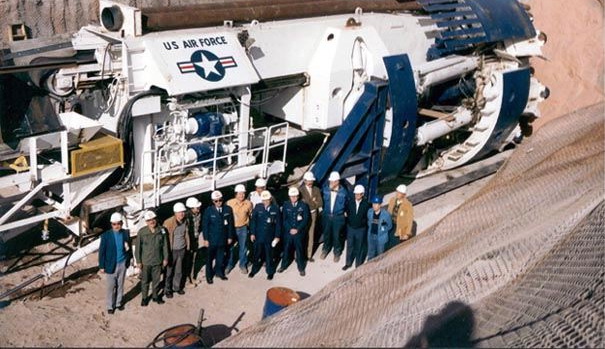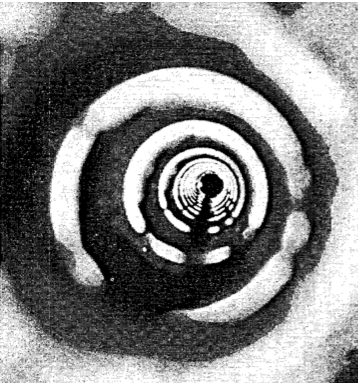This is in some ways a follow up to my earlier article about the Soviet’s nuclear “Battle Mole” designed to tunnel through rock and destroy underground American bunkers.
Of course, the United States developed its own machines as well. In November 1970, Los Alamos scientists put out “A Proposal for LASL Development of a Nuclear Subterrene,” recommending the paper study be expanded to a feasibility study, with the ultimate objective of building a device “capable of penetrating the earth to depths of tens of kilometers…” Of course, it was officially to study the depths of the Earth, not to build secret bases on the Moon, which we were just starting to visit at that time… or to build underground secret bunkers to survive WWIII or a pole shift…
“In April of 1971, the program was submitted to the National Science Foundation. Funding was ultimately approved through the Research Applied to National Needs program and work began in 1972, with the first patent for a nuclear or electrical melting penetrator filed the same year.” Such a tunnelling machine would not need to be refueled often or make underground noise like a convential mechanical drilling machine. It would be well-suited for use on the moon, or for secret projects, or for planting nukes under the cities of enemy nations for a pre-emptive first strike, or as a deterrent to avoid Mutually Assured Destruction.
From the article: Nuclear SubSelene Tunneling Machines on the Moon?
“Documents from Los Alamos National Laboratory and from Texas A&M University (under contract to NASA) indicate that there are plans to use “nuclear subselene tunneling machines” to melt tunnels under the Moon’s surface, to make living, working, mining and transportation facilities for a lunar colony.

Photo of United States Air Force tunnel boring machine at Little Skull Mountain, Nevada, USA, December 1982
A 1986 Los Alamos report calls for using a fission powered, nuclear subselene to provide the heat to “melt rock and form a self-supporting, glass-lined tunnel suitable for Maglev or other high-speed transport modes.” The report recommends burrowing beneath the surface because of the harsh lunar environment. (This would apply to Mars as well.) …tunnels would need to be hundreds, or thousands of kilometers long…” In 1986, Los Alamos estimated each subselene could be built for about million and transported to the Moon for anywhere from 5 million to ,323 million. The price tag may seem exorbitantly high, but rest assured that there is easily that much, and more, available in the military’s “black” budget for covert projects. It should be noted that the report did not specify how the subselenes and their crews would be transported to the Moon.

A tunnel made with a thermal penetrator (rock melter) at the front
A 1988 Texas A&M study outlined plans for a slightly different model of lunar tunnel boring machine. The Texas A&M “Lunar Tunneler” would employ a “mechanical head to shear its way through the lunar material while creating a rigid ceramic-like lining”. Essentially, this kind of machine would be a hybrid, mechanical TBM (Tunnel Boring Machine) that incorporates elements of the nuclear powered subselene. Although the machine would be nuclear powered it would have a mechanical cutter head that would bore through the lunar subsurface. Just behind the cutter head would be a “heating section” that would,”melt a layer of lunar material within the excavated tunnel to a depth of only a few inches. This molten material could then be cooled to form a rigid ceramic material suitable for lining the interior of the tunnel.” The Texas A&M designers considered a couple of different muck disposal schemes.
The two variants of the first called for the muck to be transferred vertically to the surface and either dumped or “sprayed” into a tailings pile. The second concept called for the use of special, tunnel dump trucks that would carry the muck out of the tunnel and dump it on the lunar surface. The designers recommend use of a SP-100 fission reactor for power, using liquid lithium heat pipes of the sort developed by the Los Alamos National Laboratory for the nuclear subterrene.

A second Texas A&M study, released in May 1988, also recommended use of a lithium cooled nuclear reactor as the power source for a lunar tunneler. In the second tunneler design, there are no mechanical tunneling components. Instead, the cone-shaped, nuclear powered tunneler melts its way through the subsurface like a subterrene.
Some of the melted rock and soil is plastered against the tunnel walls to form a glass-like ceramic tunnel lining. The rest of the melted muck (called regolith) is passed out of the back of the tunneler and then carried to the surface for the disposal by the dump trucks that follow the tunneler through the tunnel.
I don’t know if there are nuclear tunneling machines secretly making permanent bases and tunnels on the moon. But NASA plans certainly give cause to wonder. And some of the images from the Clementine and Apollo missions of the numerous anomalous structures on the surface of moon, especially the near infrared images which Richard Hoagland believes show a network of structures both above and below the lunar surface, give even more cause to wonder.”
Many claim there are already hundreds, even thousands of miles of tunnels and bunkers underneath the United States in preparation for… who knows what they’re most worried

about. And whether you hide out a problem deep under the Earth’s surface or build extensive lunar bases, either would be some of the safest place to survive catastrophes on Earth like a nuclear WWIII or a catastrophic, surface-wrecking POLE SHIFT.
